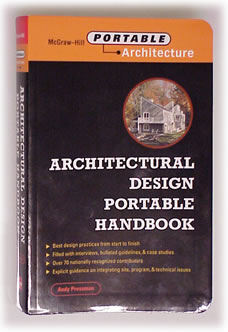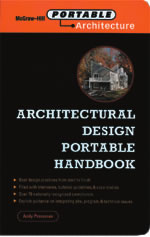
by Andy Pressman, AIA (McGraw Hill, 2001)

Managing Editor
At first I didn't get this book. Why persuade dozens of today's best thinkers-about- architecture to contribute to an opus on the exalted topic of architectural design—and put it in a petite package just a tad larger that 8" x 6"? Why not do it hard cover—instead of lightweight and plastic-covered? But, it's Andy Pressman's work, and I really like the other books he's written, so . . .
. . . I tossed it in my backpack to read on the subway. It also fit snug in my briefcase, traveling with me when I knew there would be a few minutes of waiting—and reading—time. But it wasn't until I slopped mocha yogurt on the slick cover—and cleaned it up easily and instantaneously—that the light dawned, fully illuminating a book design conscious of how architects and students actually would use it. They will read it at lunch and on the go, one essay at a time, and draw small and careful inspirations from the pieces.
The content of these pieces is painstakingly constructed into a framework supplied by Pressman by introducing each of the essays and imposing a structure of common voice throughout. The essays themselves—there are 82 of them, most written with coauthors—run the design-process gamut from preprogramming ("inspiration") through a manifesto for the future ("getting wired"). Not all will ring everyone's bell (there are two that shouldn't be in there at all—but I won't say which ones), yet everyone will find plenty personally appealing.
From goosebumps to
acoustics
It is difficult to capture the many facets of architecture with the written
word, and this Portable Handbook
does an admirable job. The author does not deny the magic of creating
architecture, in fact he calls the lead (and truly top-notch) essay, an
interview with Antoine Predock, FAIA, "The Goosebump Factor."
Pressman also explains early on that the linearity of the written word
cannot capture fully the iterative nature of the design process.
Variation in presentation helps reinforce this iteration. As in previous books, Pressman uses straight text interspersed with question-and-answers and interviews. The words are well seasoned with sketches galore, including some real beauties by Pencil and Pen Wizard Paul Laseau in "Drawing as Discovery." Even the more arcane topics, such as acoustics, sing at the hands of their particular maestros; in this case acoustician Gary Siebein, AIA, who wrote "Ten Things Every Architect Should Know About Acoustics that Your Teachers Never Told You." Here's Number 3: "You Cannot Understand What a Priest Says in a Cathedral."
 Rethinking
practice
Rethinking
practice
The pre- and post-design phase concerns are more compelling than many
of the "design" chapters themselves. For instance, Karen Greenstreet,
PhD, president of Greenstreet Consulting, and Bob Greenstreet, RIBA, PhD,
dean of the University of Wisconsin/Milwaukee's school of architecture,
offer a chapter on presentations that is worth the price of admission
for its tips on communicating with clients. The premise: "The client
probably does not have your visual skills and cannot 'read' drawings fluently."
Ralph Kaplan offers "Ten Ways of Looking at a Building," as
seen through the eyes of a client: "Most people don't think like
architects. And architects too often don't think like people. If they
did, they might begin asking the questions that people ask: How big? How
much? How soon?"
It's tough to wind down from such heady material, and the last piece by Pressman, "Toward Great Architecture: Top 10 Snippets" does it nicely. It distills 600 pages into 10 big ideas for practicing architecture into the future. They range from "demarginalize practice" to "communicate effectively with clients, colleagues, and the public" to "pursue lifelong learning." It is striking how well these ideas dovetail the AIA's Aligning the Institute for the Millennium (AIM) strategic plan, renewed interest in ethics, the rise of mandatory continuing education, and passion for speaking the language of clients and the public. We are, it seems, poised for a new paradigm of professional development, and should thank Pressman and company for offering this handy roadmap.
Copyright 2001 The American Institute of Architects. All rights reserved.
![]()
|
The Architectural Design Portable Handbook is available from the AIA Bookstore—800-242-3837 option 4.
|
|
